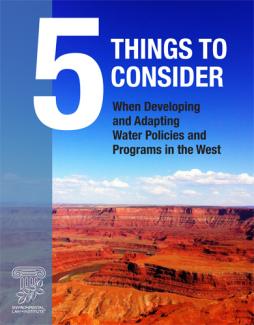Five Things That Can Make or Break Water Solutions in the West
A new ELI guidebook puts a twist on water policy development. Focusing on what influences success, it lays out key factors that ultimately determine the success or failure of water initiatives in the Western United States.
Five Things to Consider When Developing and Adapting Water Policies and Programs in the West

This guidebook identifies common factors that influence the success of water policies or programs in the prior appropriation context, and provides examples of each factor to further clarify the issue. The guidebook is intended to help decision-makers at the state and local levels develop new policies and programs that are best tailored to navigate potential obstacles to achieving the desired outcomes.
Anchoring the Clean Water Act: Congress's Constitutional Sources of Power to Protect the Nation's Waters
Recent Supreme Court rulings have called into question federal Clean Water Act coverage for certain wetlands and streams. Legislation recently introduced in the House of Representatives would amend the Act to restate and clarify Congress’s intent to regulate the waters of the United States to the fullest extent of its legislative power. The Environmental Law Institute has issued a new white paper that identifies which constitutional powers Congress can rely on to protect the Nation’s waters, and explains in straightforward language what the Supreme Court has said about these powers.
At the Confluence of the Clean Water Act and Prior Appropriation: The Challenge and Ways Forward

This report (1) details the impact that water quantity law and practice has had on water quality, and likewise water quality rules on water quantity management; (2) analyzes the legal authorities of states and the federal government over water quantity and quality, respectively, and briefly recaps the current state of takings law relevant to appropriative rights and the Clean Water Act; and (3) identifies laws, policies, government structures, and other factors that can advance relationships between, and ultimately the outcomes for, water quality and quantity management.
Bridging the Divide Between Water Quality and Quantity Management in Western U.S.
(Washington, DC) — A new report by the Environmental Law Institute sheds light on the deep divide between surface water quality and quantity management in the American West and suggests ways to bridge that gap.
Contact the Western Water Program
ELI Office
1730 M Street, NW
Suite 700
Washington, DC 20036
Phone: (202) 939-3800
Fax: (202) 939-3868
Program Director
Adam Schempp
